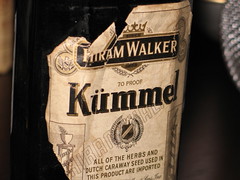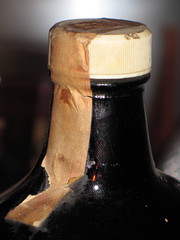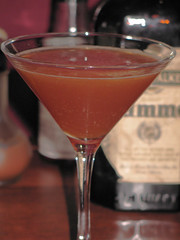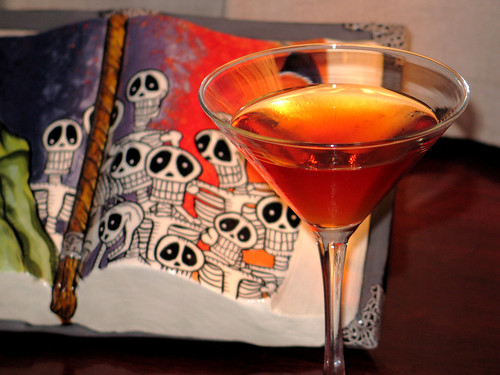The Vowel Cocktail
Danger, Will Robinson! It’s an obscure ingredient!
Actually, it’s not that obscure. You can get the currently available brand at Beverage Warehouse if you’re in the L.A. area, or anywhere you’ve got a nicely-stocked spirits store, I’d imagine.
I found mine in a rather unlikely place …
Kümmel is a spirit from Germany that’s complex and herbal, with its primary flavoring agent being caraway. Nowadays the brand you’ll tend to find is Gilka, from Berlin, but that stuff’s $28 a bottle and it was a little low on my liquor-purchasing list.
Then I spotted an ancient-looking bottle just like this in the liquor cabinet at our friends’ Gregg and Mike’s house, as we were invited to just dig in and mix.
“Where’d you get this?!” I asked.
“At the little liquor store up on Colorado, across the street from Fatty’s, believe it or not.” Right in our neighborhood. “There was another bottle left, too!”
I sped to the little liquor store the next day, and there it was, very bottom shelf behind the counter, marked $9.99. The ladies behind the counter seemed befuddled that I wanted it, and even more so because that bottle had probably been sitting on their bottom shelf since long before they bought that store. They argued briefly as to whether or not to give me some kind of discount — “Who would want that?” I heard the younger one say. However, Big Mama won out, and said to charge me as it was marked. I didn’t care … if I was going to experiment with a new liqueur (and caraway is one of those tastes I’ve always disliked but have barely begun to acquire), $10 was better than $28. And a vintage bottle, no less! I was feeling very Dr. Cocktail, realizing, of course, that an old bottle of Hiram Walker anything is pretty much worthless.
The contents were far better than worthless, though. I still haven’t tasted the good stuff from Gilka, but this stuff wasn’t bad at all — the caraway predominated, but it was pretty complex, and wasn’t all that sweet (which, for me, is good).
This led us to finally be able to try one of the cocktails in Vintage Spirits and Forgotten Cocktails that we hadn’t gotten to yet — The Vowel Cocktail.
The Vowel Cocktail
1 ounce blended Scotch.
1 ounce sweet vermouth.
1/2 ounce kümmel.
1/2 ounce orange juice.
2 dashes Angostura Bitters.Shake and strain. No garnish.
It looks a little brown and murky, but the flavor of this drink is like nothing you’ve tasted before.
Wes and I took a sip and our eyebrows shot up. It was very caraway-y, and I probably shouldn’t have liked it. But there was a lot going in in there … My first impression was to say, “This is weird,” as in, “This is really different, which it was.
Second sip. “What do you think?”
“I think it’s really good.”
“I think it’s really good, me too!”
Lots and lots going on in this drink, from rye bread to a hint of smoke to spice and a little citrusy tang. We immediately wanted pastrami sandwiches after this drink but alas, had to wait until the next day for that.
There was just one thing … Apparently the recipe for the Vowel Cocktail is the ONE publisher’s misprint in [the first edition of] Doc’s book! The text reads as 1-1/2 ounces kümmel, which seemed strange to me but I went ahead and made it anyway, and ended up liking the result. When we tried it again with the proper amount of 1/2 ounce kümmel, there was much less assertiveness and more subtlety from the kümmel, which was a good thing. The basic flavor combinations still worked really well.
The good news is that this is another step towards my acquisition of the flavor of caraway, which I had never liked in the past. Next stop, aquavit!










